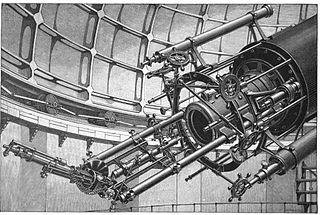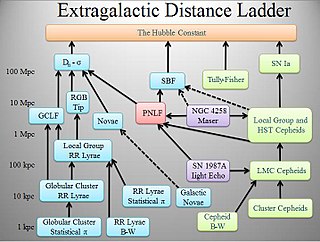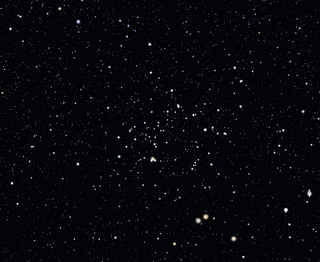Spectroscopic parallax is an astronomical method for measuring the distances to stars. Despite its name, it does not rely on the geometric parallax effect. This technique can be applied to any main sequence star for which a spectrum can be recorded. The method depends on the star being sufficiently bright to provide a measurable spectrum, which as of 2013 limits its range to about 10,000 parsecs. [1]

Parallax is a displacement or difference in the apparent position of an object viewed along two different lines of sight, and is measured by the angle or semi-angle of inclination between those two lines. Due to foreshortening, nearby objects show a larger parallax than farther objects when observed from different positions, so parallax can be used to determine distances.

In astronomy, the main sequence is a continuous and distinctive band of stars that appears on plots of stellar color versus brightness. These color-magnitude plots are known as Hertzsprung–Russell diagrams after their co-developers, Ejnar Hertzsprung and Henry Norris Russell. Stars on this band are known as main-sequence stars or dwarf stars. These are the most numerous true stars in the universe, and include the Earth's Sun.

Astronomical spectroscopy is the study of astronomy using the techniques of spectroscopy to measure the spectrum of electromagnetic radiation, including visible light and radio, which radiates from stars and other celestial objects. A stellar spectrum can reveal many properties of stars, such as their chemical composition, temperature, density, mass, distance, luminosity, and relative motion using Doppler shift measurements. Spectroscopy is also used to study the physical properties of many other types of celestial objects such as planets, nebulae, galaxies, and active galactic nuclei.
To apply this method, one must measure the apparent magnitude of the star and know the spectral type of the star. The spectral type can be determined by observing the star's spectrum. If the star lies on the main sequence, as determined by its luminosity class, the spectral type of the star provides a good estimate of the star's absolute magnitude. Knowing the apparent magnitude (m) and absolute magnitude (M) of the star, one can calculate the distance (d, in parsecs) of the star using (see distance modulus). The true distance to the star may be different than the one calculated due to interstellar extinction. [2]

Apparent magnitude is a measure of the relative brightness of a star or other astronomical object as seen by an observer. An object's apparent magnitude depends on its intrinsic luminosity, its distance from the observer, and any extinction of the object's light by interstellar dust along the line of sight to the observer.
Absolute magnitude is a measure of the luminosity of a celestial object, on an inverse logarithmic astronomical magnitude scale. An object's absolute magnitude is defined to be equal to the apparent magnitude that the object would have if it were viewed from a distance of exactly 10.0 parsecs, without extinction of its light due to absorption by interstellar matter and cosmic dust. By hypothetically placing all objects at a standard reference distance from the observer, their luminosities can be directly compared on a magnitude scale.
The distance modulus is a way of expressing distances that is often used in astronomy. It describes distances on a logarithmic scale based on the astronomical magnitude system.
The method ultimately derives from the spectroscopic studies of sunspots and stars by Walter Sydney Adams and Ernst Arnold Kohlschütter. [3]

Walter Sydney Adams was an American astronomer.








